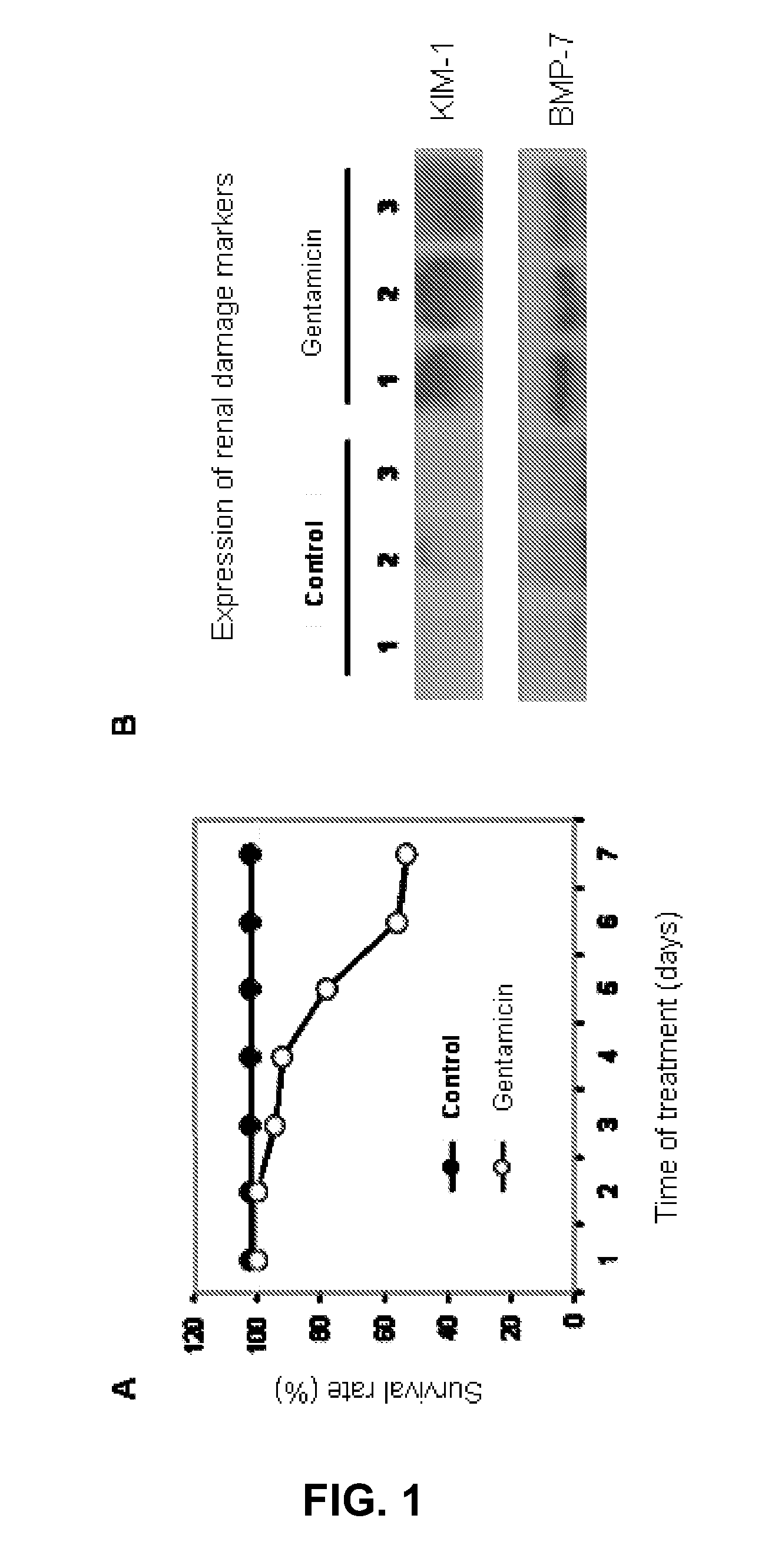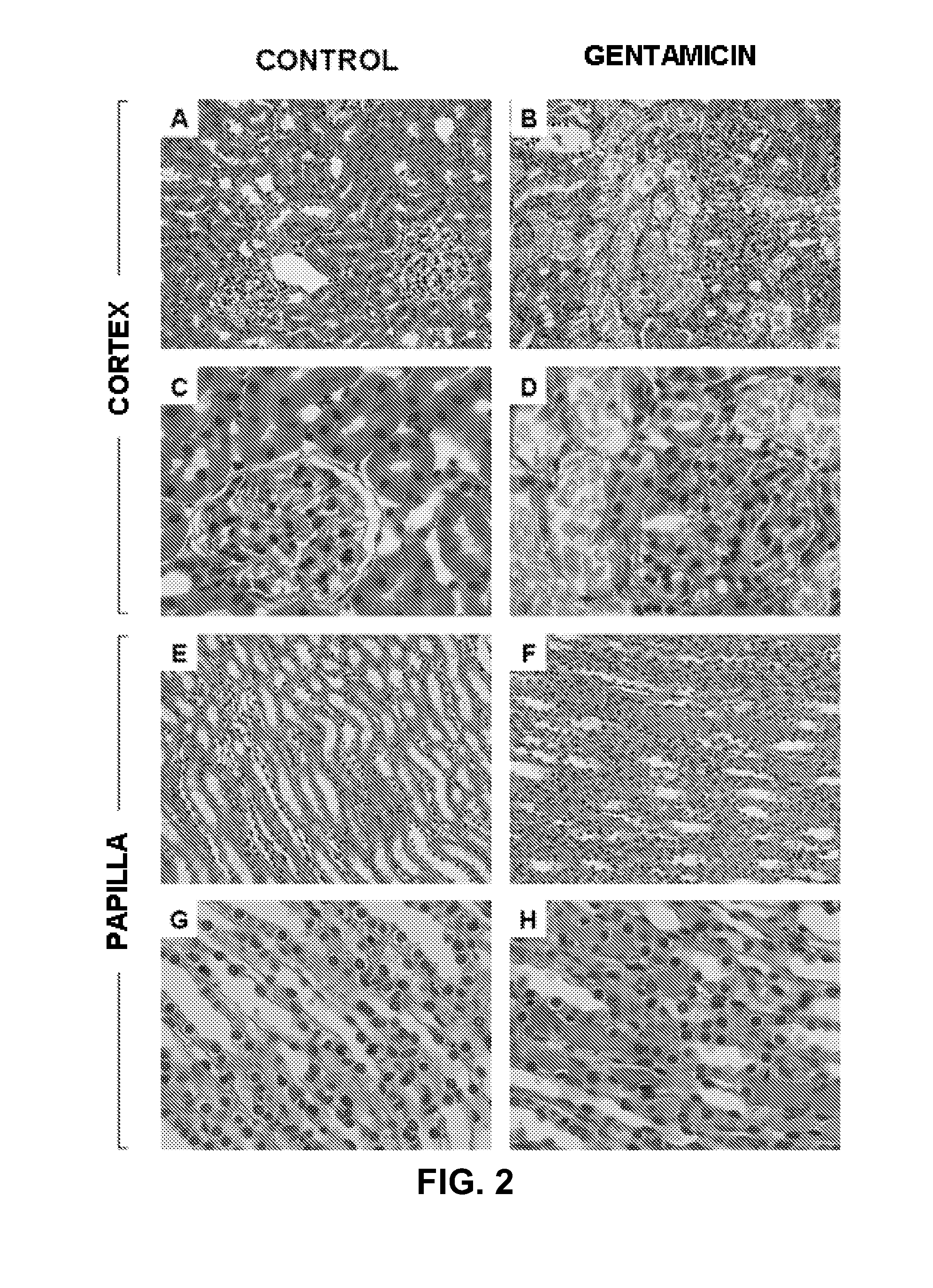Method for the detection of renal damage
a technology for renal damage and detection methods, applied in the field of renal damage detection, can solve problems such as acute renal failure of renal damag
- Summary
- Abstract
- Description
- Claims
- Application Information
AI Technical Summary
Benefits of technology
Problems solved by technology
Method used
Image
Examples
example 1
Materials and Methods
1.1. Animals and Experimental Protocol.
[0150]Female Wistar rats were used weighing 200-250 g. The animals were allocated under controlled environmental conditions in individual metabolic cages, for individual urine sample collection every 24 hours. Normal feed and water were administered ad libitum. Rats were randomly divided in two groups: (i) control group (C), receiving daily placebo i.p. during 6 days, and (ii) gentamicin group (G), receiving gentamicin i.p. (150 mg / kg of body weight) during 6 days. On day 7, the animals were anaesthetised with sodium pentobarbital and the kidneys were perfused by the aorta with saline (0.9% NaCl) to eliminate the blood. The kidneys were immediately dissected. One was frozen in liquid nitrogen and subsequently kept at −80° C. for Western blot studies, and the other was soaked in p-formaldehyde at 3.7% for histological studies. Blood samples were also obtained in heparinised capillaries at different time points by a small inc...
example 2
Characterisation of Gentamicin-Induced Kidney Damage
[0162]After 7 days treatment, gentamicin caused a marked renal damage (acute kidney injury or acute renal failure) with an associated mortality of about 50% (FIG. 1 and table 2). Surviving animals coursed with a small but significant weight loss and polyuria. Acute renal failure was further characterised by a dramatic increase in serum creatinine and BUN concentration, indicating a reduction of GFR. NAG excretion also increased over a large area, indicating extensive tubular damage. Proteinuria was also evident in the urine of animals treated with gentamicin (Table 2).
TABLE 2Body weight (shown as a percentage of the initial weight), plasma creatinine concentration,blood urea nitrogen (BUN), proteinuria, NAG excretion and urinary flow in control andgentamicin rats after 7 days treatment at p n = 12 at the beginning of the experiment in both groups.ΔUrineWeightCreatinineBUNProteinuriaNAGflow(%)(mg / dL)(mg / dL)(mg / day)(UA / day)(mL / day)Co...
example 3
Renal Histopathological Study
[0163]Kidney sections stained with hematoxilin-eosin (FIG. 2) revealed a clear tubular necrosis in gentamicin rats, where massive epithelial destruction can be observed. An important modification of the glomerules is not evident. On a papillary level, obstruction of the collector tubules with hyaline material is common in animals treated with gentamicin. These studies provide the morphological backup for at least part of the extensive renal dysfunction observed.
PUM
| Property | Measurement | Unit |
|---|---|---|
| molecular weight | aaaaa | aaaaa |
| concentration | aaaaa | aaaaa |
| pH | aaaaa | aaaaa |
Abstract
Description
Claims
Application Information
 Login to View More
Login to View More - R&D
- Intellectual Property
- Life Sciences
- Materials
- Tech Scout
- Unparalleled Data Quality
- Higher Quality Content
- 60% Fewer Hallucinations
Browse by: Latest US Patents, China's latest patents, Technical Efficacy Thesaurus, Application Domain, Technology Topic, Popular Technical Reports.
© 2025 PatSnap. All rights reserved.Legal|Privacy policy|Modern Slavery Act Transparency Statement|Sitemap|About US| Contact US: help@patsnap.com



